Quake-stunned Nepal still awaits food, tents, and clean water
Loading...
| Kathmandu, Nepal
Four days after a devastating earthquake, tens of thousands of survivors here still urgently need clean water, food, and tents to survive the aftermath.
Nepali officials are not yet aware of the extent of destruction or of the need in many places outside Kathmandu. But even this capital city and its neighboring districts are waiting for supplies amid steady rains that have further hindered recovery efforts.
Many residents are leaving Kathmandu for fear of aftershocks or disease, or because of scalpers' prices for basic necessities. Meanwhile, the United Nations is preparing to build camps for residents whose homes are destroyed or unsafe.
But local sources say foreign aid organizations are bumping into each other and into Nepali recovery teams. Despite their strong efforts, many residents interviewed today have so far seen no aid.
The destruction wrought by Saturday’s earthquake, Nepal’s biggest since 1934, has claimed more than 4,600 lives, according to the most recent estimates. Prime Minister Sushil Koirala said on Tuesday that the death toll could reach 10,000.
In terms of both information and need, “the big challenge is in remote areas,” UN resident coordinator Jamie McGoldrick said Tuesday. He said more supplies are needed “closer to the epicenter of the earthquake,” in the Gorkha district northeast of Kathmandu.
Water shortages
Nepali officials describe an urgent need of ready-to-eat food, water, and tents in all parts of the poor, mountainous nation of 28 million people.
In Kathmandu, where water scarcity is chronic, some private water suppliers are supplying water through tankers on their own for free.
“There are 700 water tankers in Kathmandu. But now only 100 of them are operating because drivers of the rest have either returned to the villages to take care of their families or are grieving the loss of someone in the family,” says Radha Krishna Gumi, the owner of a private water supply company here.
Operators normally charge $25 for about 3,500 gallons of water. But now they are supplying it for free and without having received a government request. “We are doing this out of humanitarian concerns. There is a serious shortage of drinking water in Kathmandu,” Mr. Gumi says.
The 7.8-magnitude earthquake took a serious toll on Nepali villages, many of which in Gorka are completely destroyed or flattened. Tents are an immediate necessity.
The Sindhupalchowk district that adjoins Gorkha has reported the single highest casualty rate. Thousands of houses in nearly 500 communities and villages are destroyed, according to the district’s chief government administrator, Krishna Gyawali.
“The scale of destruction in the district is indescribable," Mr. Gyawali says. "We need tents, clean water, and food to save those who survived."
A helicopter dropped relief goods at the Sindhupalchowk district headquarters Tuesday. But Gyawali says it isn’t possible for security personnel and government officials to take these supplies to the affected villages.
“The supplies need to be airdropped. Bringing them to us only adds to our problems," Gyawali says. "We don’t have enough manpower. Many of the affected areas cannot be reached by roads."
The death toll in Sindhupalchowk has hit 1,250, but Gyawali says the actual number may be even higher given the remoteness of some villages.
Waiting for aid
Persistent bad weather has prevented helicopters from flying into larger portions of districts outside the capital and around the epicenter to make damage assessments, according to Nepal Home Ministry spokesman Laxmi Prasad Dhakal.
“We have limited equipment to help us take stock of the situation,” he says.
Foreign rescue teams are now being seen in all parts of Kathmandu. But at some of the sites where rescue work is under way, their presence appears to many Nepali rescue teams to sometimes be ceremonial.
“They are wasting time for photo shoots,” a junior police official complains about one Asian-based rescue team working at a rescue site in the northern outskirts of Kathmandu. “They are slowing us down."
While many nations have announced help for Nepal, the flight schedule in and out of Kathmandu airport is chaotic, despite the fact that the airport is now open 24 hours. Special flights are arriving regularly loaded with aid, but the actual delivery of relief is not easily spotted on the ground.
“We are on our own,” says Sushil Pandey, a student in the Sohrakhutte neighborhood in central Kathmandu. Mr. Pandey has spent three nights under a tent inside a local college, waiting for relief.
Trishna Shahi, who is spending her fourth night under an open sky, shares similar concerns. “We heard that relief aid has come to Nepal," she says. "But where is it?”
Ms. Shahi and Pandey said people are being overcharged for everything, including transportation fares and water.
Police spokesman Kamal Singh Bam admitted that this is happening. He says police are trying to address makeshift vendors and others who are exploiting the ongoing crisis.
Along with uncollected garbage in Kathmandu, many corpses have been left in overcrowded morgues and under collapsed buildings, raising serious health concerns.
The Gongabu bus park, the city's biggest long-distance bus terminal, is almost empty.
“This is because vehicles aren't coming to Kathmandu," says Dipak Kunwar, a traffic officer posted at the terminal. "Those that were here have left."







